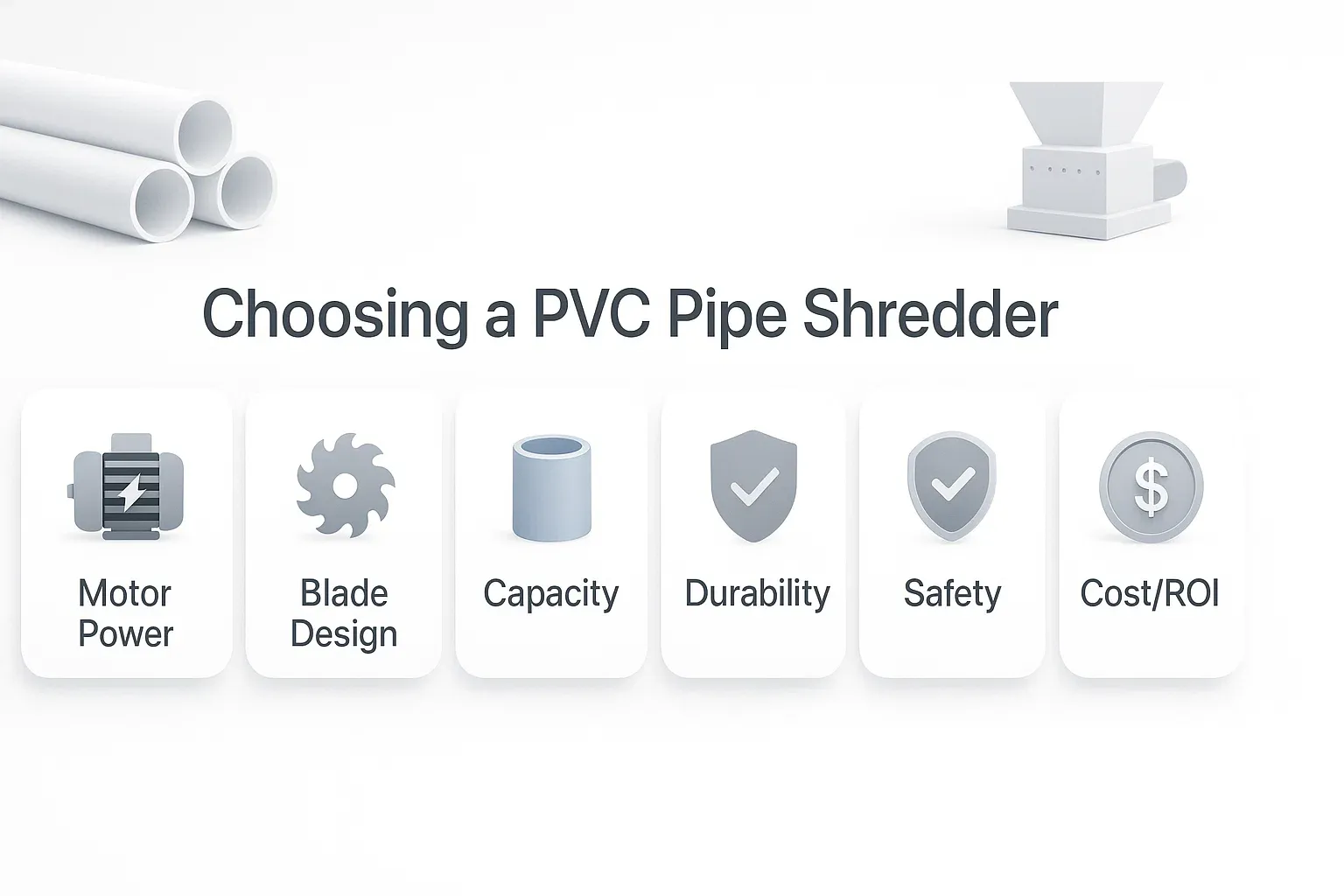Dealing with PVC pipes, whether from manufacturing surplus or recycling efforts, can be a significant challenge without the proper equipment. Investing in a high-quality PVC pipe shredder is crucial for efficiently managing this durable material. But with a diverse market offering various models, how do you pinpoint the perfect shredder for your unique requirements? This guide will walk you through the essential factors to consider, empowering you to select a PVC pipe shredder that effectively balances performance, capacity, and cost-effectiveness.
First, Understand Your PVC Waste Stream
Before diving into shredder specifications, take a moment to assess the PVC pipes you’ll be processing:
- Pipe Diameter and Wall Thickness: Are you dealing with small, thin-walled pipes or large, industrial-grade ones?
- Volume and Frequency: How much PVC material do you need to shred daily or weekly?
- Contamination Levels: Are the pipes clean, or do they contain dirt, debris, or other materials? Answering these questions will provide a clearer picture of your needs and help narrow down your options.
Key Factors to Consider When Choosing a PVC Pipe Shredder
Once you have a good understanding of your materials, consider these critical aspects of the shredder itself:
1. Motor Power and Efficiency: The Driving Force
The motor is the engine of your PVC pipe shredder, dictating its capability to tackle various PVC pipe sizes and thicknesses. A more robust motor translates to faster shredding, enabling you to process higher volumes of material more quickly. Typically, PVC pipe shredder motors range from 10 HP to over 100 HP.
- Light-Duty Use (e.g., small-scale recycling, occasional use): A shredder with a 20-30 HP motor might suffice.
- Medium-Sized Operations: Motors in the 30-50 HP range often strike a good balance.
- Industrial Operations (e.g., large recycling facilities, continuous manufacturing waste): These applications will likely demand motors with 50 HP or more to handle larger pipes and continuous, demanding operation.
While power is crucial, also consider energy efficiency. Modern shredders often incorporate designs or features like Variable Frequency Drives (VFDs) to optimize power consumption, reducing operational costs without sacrificing performance. An underpowered motor will struggle, leading to jams and inefficiencies, while an overly powerful one might lead to unnecessary energy expenditure.
| Motor Power Range | Ideal Use Case |
|---|---|
| 10-30 HP | Small recycling or hobbyist use |
| 30-50 HP | Medium-sized operational demands |
| 50+ HP | Industrial and high-volume shredding |
2. Blade Design, Material, and Quality: The Cutting Edge
The blades are where the action happens in a PVC pipe shredder. Their design and quality directly influence the cleanliness and efficiency of the cuts. PVC pipes, known for their toughness and varying dimensions, require high-quality, hardened steel alloy blades (e.g., D2 tool steel) to ensure durability, wear resistance, and longevity.
Key Blade Features to Consider:
- Blade Material: Look for robust, wear-resistant hardened steel alloys.
- Blade Type & Configuration: Shredders can have single-shaft designs with a rotor and stator (stationary) knives, or dual-shaft designs with intermeshing cutters. The configuration impacts particle size and throughput.
- Adjustability & Replaceability: Blades will eventually wear down. Opt for shredders with easily replaceable or rotatable blades. Some models allow for blade adjustment to fine-tune output particle size.
- Maintenance Access: Easy access for blade sharpening, rotation, or replacement will minimize downtime and maintenance costs.
Regularly sharpening and maintaining the blades is paramount for maximizing your shredder’s performance and lifespan.
3. Processing Capacity and Pipe Size Accommodation
Not all shredders are created equal in their ability to handle different volumes and sizes of PVC pipes. It’s essential to match the shredder’s capacity with the specific dimensions and quantity of PVC pipes you intend to process.
- Feed Opening / Chamber Size: This dictates the maximum diameter of the pipe the shredder can accept. Smaller shredders might handle pipes up to 6 inches in diameter, while heavy-duty industrial shredders can process pipes exceeding 20 inches.
- Throughput Rate: Usually measured in pounds or kilograms per hour, this indicates how much material the shredder can process within a given timeframe. If you’re dealing with large quantities of PVC, a high throughput rate is crucial.
Ensure the shredder you choose can comfortably handle your current and anticipated future processing volumes.
| Feed Opening Size (Approx.) | Max Recommended Pipe Diameter | Typical Application |
|---|---|---|
| ~12 inches | Up to 6-10 inches | Smaller operations |
| ~24 inches | Up to 10-20 inches | Medium to large jobs |
| 48 inches+ | 20+ inches | Heavy industrial use |
4. Durability, Construction, and Maintenance Needs
A PVC pipe shredder is a significant investment, so durability should be a top priority. A well-constructed machine will not only save you money on repairs but also minimize operational downtime.
- Construction: Look for shredders built with heavy-duty materials, such as robust welded steel frames and wear-resistant liners in the cutting chamber.
- Maintenance: Consider the ease of maintenance. Shredders with easily accessible components (motors, gearboxes, blades) simplify routine checks and repairs. Features like centralized lubrication points or self-cleaning mechanisms can also significantly reduce maintenance time.
A durable shredder with straightforward maintenance requirements contributes to a lower total cost of ownership.
5. Essential Safety Features
Operating powerful shredding equipment inherently involves safety risks. Therefore, choosing a PVC pipe shredder equipped with comprehensive safety features is non-negotiable.
- Emergency Stop Buttons: Easily accessible and prominent.
- Safety Interlocks: Prevent operation if access panels or the hopper are open.
- Overload Protection Systems: Automatically shut down the shredder in case of jams or overfeeding, preventing motor damage and potential hazards.
- Hopper Design: A well-designed feed hopper can prevent accidental contact with moving parts and minimize material kickback.
- Rotor Lockouts: For safe maintenance procedures.
Ensure the shredder complies with relevant safety standards and that operators receive thorough training.
6. Cost Analysis and Return on Investment (ROI)
Finally, evaluate the total cost of the shredder. This extends beyond the initial purchase price. Consider:
- Initial Purchase Price: The upfront investment.
- Operating Costs: Energy consumption, labor.
- Maintenance Costs: Blade replacement/sharpening, spare parts, and routine servicing.
- Warranty and Support: Comprehensive warranty coverage and reliable supplier support can save costs in the long run.
While high-end models may have a higher initial price, they often deliver a better ROI through reduced labor needs, lower maintenance costs, superior efficiency, and longer operational life. Calculate the potential savings from reduced waste disposal fees or revenue from selling the shredded PVC material.
7. Advanced Features for Peak Performance and Convenience
Some PVC pipe shredders come equipped with additional features designed to optimize performance, safety, and environmental friendliness:
- Automatic Feeding Systems: Conveyor belts or hydraulic rams can provide a consistent and controlled material feed, improving efficiency and operator safety.
- Noise Reduction Technology: Enclosures or sound-dampening materials can significantly lower operational noise, benefiting the work environment.
- Dust Collection Systems: Crucial for managing PVC dust, which can be a health and cleanliness concern. Integrated dust suppression or collection systems help maintain a cleaner, safer workspace.
- Screening Systems: Some shredders can be fitted with screens to control the output particle size, ensuring the shredded material meets specific requirements for recycling or reprocessing.
While these features might increase the initial investment, they can significantly enhance the overall efficiency, safety, and environmental compliance of your shredding operations. For operations dealing with particularly robust materials or requiring very high throughput, exploring options like a heavy-duty HDPE plastic pipe shredder system can provide valuable insights into advanced capabilities, even if your primary focus is PVC.
Conclusion: Making an Informed Shredder Choice
Selecting the right PVC pipe shredder demands a thorough evaluation of your specific operational needs, the characteristics of the PVC pipes you’ll be processing, and your long-term objectives for efficiency and cost management. By carefully assessing motor power, blade design, capacity, durability, safety features, and overall cost, you can make a well-informed decision that will significantly boost your productivity and deliver a solid return on investment.
A PVC pipe shredder is a pivotal piece of equipment. Choosing wisely will save you considerable time, money, and effort down the line. Don’t hesitate to thoroughly explore your options and consult with reputable suppliers who can offer recommendations tailored precisely to your unique shredding challenges.



